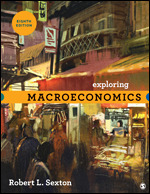Exploring Macroeconomics
Eighth Edition
- Robert L. Sexton - Pepperdine University, USA
January 2019 | 688 pages | SAGE Publications, Inc
The excitement of learning economics for the first time.
The experience of a lifetime of teaching it.
The Eighth Edition of Exploring Macroeconomics captures the excitement of learning macroeconomics for the first time through a lively and encouraging narrative that connects macroeconomics to the world in a way that is familiar to students. Author Robert L. Sexton draws on over 25 years of teaching experience to capture students’ attention, focusing on core concepts and expertly weaving in examples from current events and popular culture to make even classic economic principles modern and relatable. The text sticks to the basics and applies a thoughtful learning design, segmenting its presentation into brief, visually appealing, self-contained sections that are easier for students to digest and retain compared to sprawling text.
Thoughtfully placed section quizzes, interactive summaries, and problem sets help students check their comprehension at regular intervals and develop the critical thinking skills that will allow them to “think like economists.” Combined with a complete teaching and learning package, Exploring Macroeconomics is sure to help you ignite your students’ passion for the field and reveal its practical application in the world around them.
A Complete Teaching & Learning Package
Easy LMS Import
SAGE coursepacks for instructors makes it easy to import our quality instructor and student resource content into your school’s learning management system (LMS). Learn more.
Online Resources
SAGE edge for students, the companion website specifically designed for this text, offers a robust online environment with the learning tools and resources students need to succeed. Learn more.
The experience of a lifetime of teaching it.
The Eighth Edition of Exploring Macroeconomics captures the excitement of learning macroeconomics for the first time through a lively and encouraging narrative that connects macroeconomics to the world in a way that is familiar to students. Author Robert L. Sexton draws on over 25 years of teaching experience to capture students’ attention, focusing on core concepts and expertly weaving in examples from current events and popular culture to make even classic economic principles modern and relatable. The text sticks to the basics and applies a thoughtful learning design, segmenting its presentation into brief, visually appealing, self-contained sections that are easier for students to digest and retain compared to sprawling text.
Thoughtfully placed section quizzes, interactive summaries, and problem sets help students check their comprehension at regular intervals and develop the critical thinking skills that will allow them to “think like economists.” Combined with a complete teaching and learning package, Exploring Macroeconomics is sure to help you ignite your students’ passion for the field and reveal its practical application in the world around them.
A Complete Teaching & Learning Package
Easy LMS Import
SAGE coursepacks for instructors makes it easy to import our quality instructor and student resource content into your school’s learning management system (LMS). Learn more.
Online Resources
SAGE edge for students, the companion website specifically designed for this text, offers a robust online environment with the learning tools and resources students need to succeed. Learn more.
Part I: Introduction
Chapter 1: The Role and Method of Economics
Chapter 2: Economics: Eight Powerful Ideas
Chapter 3: Scarcity, Trade-Offs, and Production Possibilities
Part II: Supply and Demand
Chapter 4: Demand, Supply, and Market Equilibrium
Chapter 5: Markets in Motion and Price Controls
Part III: Market Efficiency, Market Failure, and the Public System
Chapter 7: Market Efficiency and Welfare
Chapter 8: Market Failure
Chapter 9: Public Finance and Public Choice
Part IV: Macroeconomic Foundations
Chapter 10: Introduction to Macroeconomics: Unemployment, Inflation, and Economic Fluctuations
Chapter 11: Measuring Economic Performance
Chapter 12: Economic Growth in the Global Economy
Chapter 13: Financial Markets, Saving, and Investment
Part V: The Macroeconomic Models
Chapter 14: Aggregate Demand and Aggregate Supply
Chapter 15: The Aggregate Expenditure Model
Part VI: Macroeconomic Policy
Chapter 16: Fiscal Policy
Chapter 17: Money, Banking, and the Federal Reserve System
Chapter 18: Monetary Policy
Chapter 19: Issues in Macroeconomic Theory and Policy
Part VII: The Global Economy
Chapter 20: International Trade
Chapter 21: International Finance
Sample Materials & Chapters
Chapter 2: Economics: Eight Powerful Ideas
Chapter 4: Demand, Supply, and Market Equilibrium

 Sage College Publishing
Sage College Publishing


